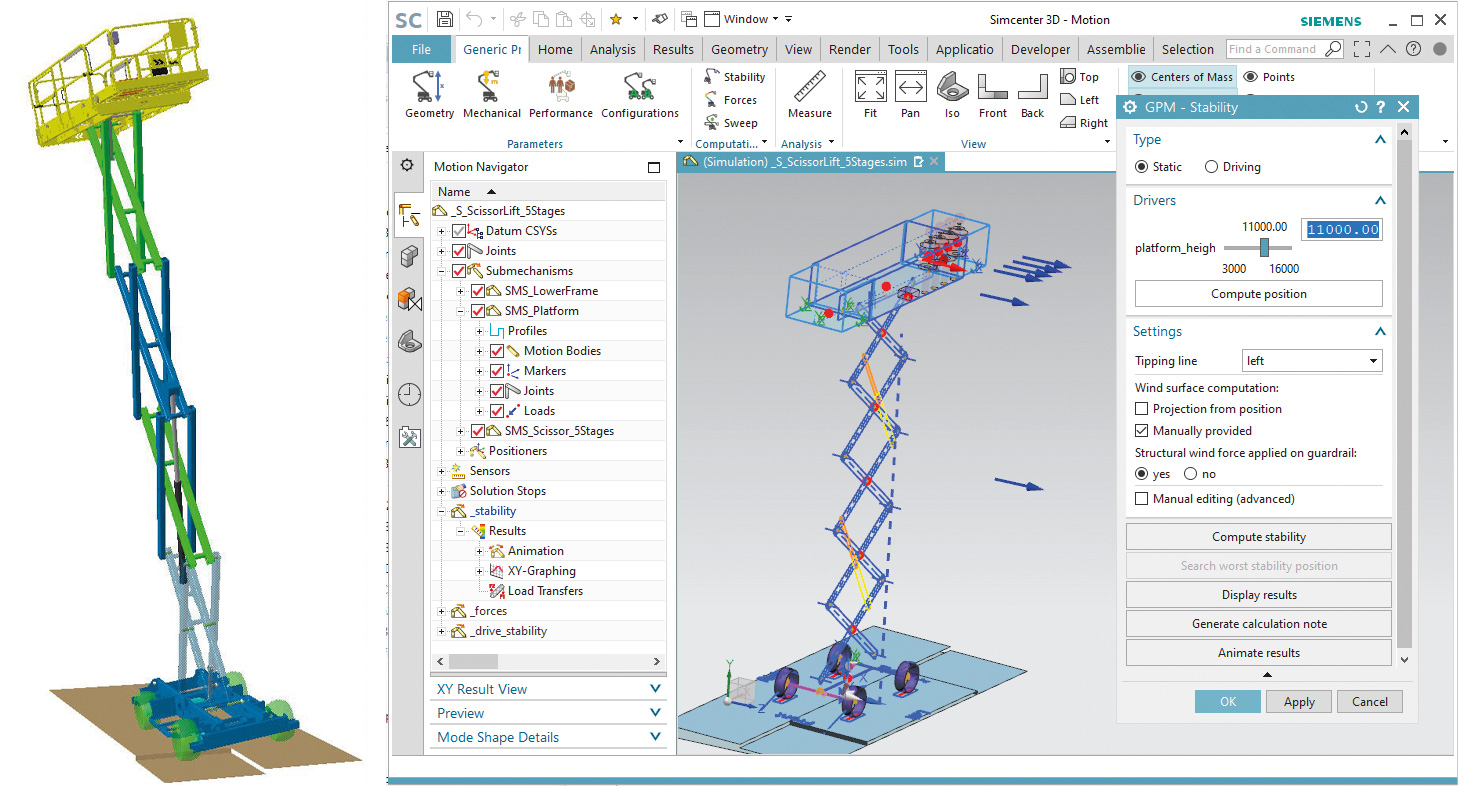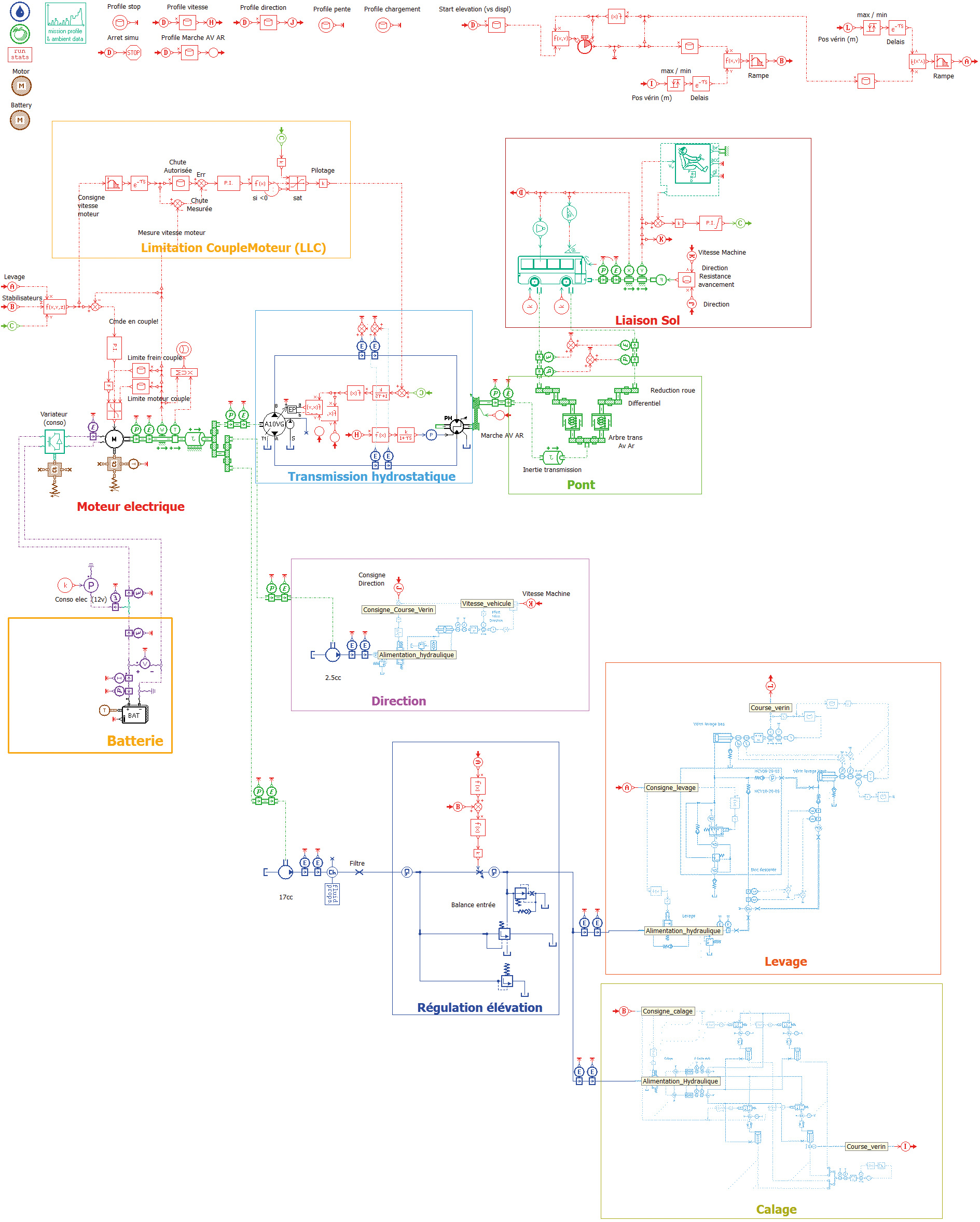STAY INTEGRATED
Letting electricity do the heavy lifting
Reducing heavy equipment power consumption and improving performance with simulation
By Luke Morris
Image provided by Haulotte
When it comes to heavy equipment, safety is absolutely vital. As is performance, efficiency, and emissions control.
Construction sites are potentially dangerous places that need to stick to tight schedules and budgets. So, they only want to use the safest, most reliable, and most economical equipment.
A common piece of heavy equipment seen across construction sites is the scissor lift used both indoors and outdoors to provide an elevated platform for workers. It needs to be able to cope with all sorts of terrain – muddy, uneven, sloped – without risking user safety or compromising performance.
Historically, these lifts have been powered by internal combustion engines that can meet the demands and pressures that they are expected to deal with. However, as construction sites strive to be more environmentally friendly and stricter regulations are imposed by local authorities, demand has grown for alternative solutions powered by cleaner energy.
Enter Pulseo by Haulotte, a range of next-generation, all-terrain electric scissor lifts.
But switching from a thermal engine to an electric motor without losing any performance is no easy task. It requires so much more than simply swapping power units. Transitioning from thermal to electric demands analysis of the entire equipment architecture to optimize it for a completely different power system.
And Haulotte didn’t want to produce an electric lift that was merely as good as older models. They wanted it to be even better.
To meet this challenge, Haulotte turned to simulation to help them design and develop the ultimate electric scissor lift. We recently spoke to Arnaud Chaigne, head of the Simulation and Digital Validation Division at Haulotte to find out why simulation was the solution and what the end results were.
Understanding the old to optimize the new
To define the optimal system architecture for the electric lift, Chaigne’s team had to ensure the battery was sized correctly. As power requirements fluctuate during operation, there’s always a risk of oversizing to ensure the machine can cope during moments of peak power demand, but this would compromise on overall performance.
Simcenter 3D Motion allowed for the modelling of the forces in the hydraulic actuators that raise the platform. By taking into account kinematics, mass distribution, friction, and dynamic effects, engineers got full insight into the pressure level details and the energy that the actuators need to do their job. This showed Chaigne and his team that the peaks in demand occurred at the very beginning of elevation when the lift started to rise.
“We started by modelling the existing thermal system in order to identify the most energy consuming parts (energy-loss mapping). By doing this, we were able to define a new architecture more suited to an all-electric machine where all energy consumption counts,” Chaigne explains. “In order to optimize the battery size, we had to develop control laws to smooth out the power peaks while offering a similar lifting time. This resulted in a constant power level during the entire elevation movement.”
Using Simcenter Amesim, they then studied a multitude of design possibilities and predicted the machine performance of each one.
“Simulation allowed us to assess the feasibility of different innovation scenarios, taking into account the impact on various systems, like hydraulics, electrics and controls, as well as machine stability and operator safety.”
Image provided by Haulotte
Keep it steady
Simcenter 3D Motion was also used to ensure the stability of the lifting mechanism both during transit and in operation. Regulations are in place to guarantee worker safety on and around elevating lifts. These stipulate that not only must they be stable when workers are on the platform, but also when the equipment is being moved into position.
The Haulotte engineers needed to anticipate all possible scenarios by studying the behaviour of the scissor lift – in particular that of the oscillating axle. Chaigne says that Simcenter 3D Motion was the perfect tool for this. “We used Simcenter dynamic multibody simulation to size the scissor lifts to ensure stability. This made it possible to find the best compromise between performance and machine weight and save time during development.”

Images provided by Haulotte
Co-simulation delivers the best results
Co-simulation is a technique where global simulation of a coupled system can be achieved by composing the simulations of its parts. Simcenter’s wide portfolio of software enables co-simulation by allowing for the easy exchange of information between each tool.
For the Pulseo range, Haulotte engineers used Simcenter 3D for structure and stability analysis and Simcenter Amesim for energy analysis and battery sizing. “Firstly, the two software programs operate simultaneously and exchange information to converge toward a common solution,” Chaigne explains. “We also use Simcenter 3D Motion to generate force tables according to the cylinder position. This information is then transferred to and used in Simcenter Amesim.”
Chaigne notes that analysing the pressure balance in the hydraulic actuators and the resulting stress distribution is key to improving performance. “Co-simulation allows us to analyse the stresses under normal conditions and during failures. We can see how the load transfers take place and the impact on hydraulic cylinder pressure.”
Democratizing simulation
In the past, use of simulation models has been restricted to specialists due to their complexity and the need for a full understanding of the tools involved. This has slowed down development as teams have had to wait for these specialists to process information at key stages of projects.
But this is changing thanks to what has become known as the ‘democratisation’ of simulation
“As a simulation expert, I am responsible for making sure our simulation tools are accessible,” says Chaigne. “The customisation possibilities in Simcenter 3D via NX Open have made it possible to integrate our business rules and regulatory norms to speed up the calculation process and reduce the risk of error.”
In the case of stability analyses, the team must work to standard norms which vary between regions. Each will have different requirements for environmental, operator impact, and equipment handling factors. To improve and speed up the analysis process, Haulotte has developed a customised process-oriented workflow tool using the NX Open software automation module for Simcenter 3D. In short, this allows them to automate data entry taking into account the various norms of different regions. Chaigne explains, “During post-processing, it provides clear-cut stability information. This enables non specialists to use more complex Simcenter 3D Motion models.”
Image provided by Haulotte
Lower costs, improved performance
The success of simulation has meant that Haulotte has been able to save both time and money by reducing the amount of physical testing required. Chaigne notes that the test phase remains essential but is much more streamlined thanks to Simcenter. “Simulation helps us identify the most critical cases in terms of stability, evaluating parameters like machine position, loads and forces.”
And when testing does highlight issues, simulation provides a deeper insight into the cause and helps to find the solution. “To reproduce the performance accurately, you have to model different physical phenomena. This includes identifying influential parameters and evaluating alternatives immediately. Working like this, we can reach the prototyping phase with a more mature, even definitive architecture.”
But what about the performance of the final product? Let’s compare past with present.
The older internal combustion powered lift had a 23kW thermal engine, maximum working drive height of 12m, and a loading capacity of 500kg.
Haulotte’s Pulseo lifts are powered by a 12kW electric motor. The working drive height has increased 25% to 15m and the loading capacity has increased by 50% to 750kg.
That’s a huge performance increase and an equally huge reduction in power. Of course, the new scissor lifts comply with all the operational stability safety standards across different regions. And thanks to being electric, they’re pollution-free and much quieter, enabling them to meet any noise and carbon emission regulations.
So, if you were thinking that some heavy equipment requires too much power to switch to electric energy, think again. Harness the power of simulation and you’ll start to see things very differently.

Image provided by Haulotte
